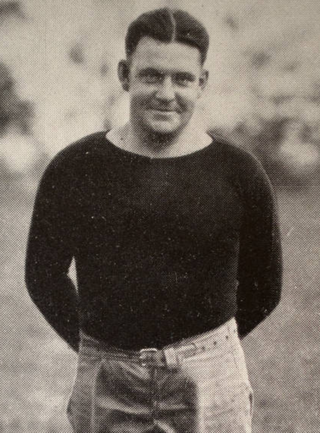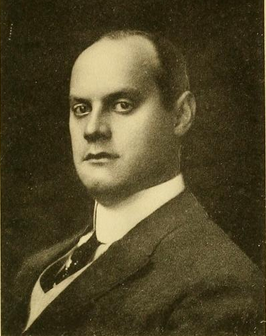
Frank Henry Mountain was an American baseball player from 1880 to 1886. He played seven seasons in Major League Baseball, principally as a pitcher, outfielder and first baseman. He played for six different major league clubs and saw his most extensive playing time with the Columbus Buckeyes of the American Association, appearing in 128 games for that club during the 1883 and 1884 seasons.

Arthur Wilson Whitney was an American professional baseball player whose career spanned from 1877 to 1893. He played 11 seasons in Major League Baseball, principally as a third baseman and shortstop, for eight different major league clubs.

James Donald Bond Jr. was an American professional football player and coach. He played college football at the University of Pittsburgh from 1915 to 1920, with his career being interrupted by military service and injuries sustained in World War I. He also played in the National Football League for the Brooklyn Lions in 1926. He coached college football at Centre College (1922), the University of Buffalo (1923), Canisius College (1924), and Albright College (1925).
Frederick Patrick Reed was an American college football coach and medical doctor.

Samuel W. Trott was an American professional baseball player and manager whose career spanned from 1877 to 1891. He played eight seasons in Major League Baseball, principally as a catcher, for the Boston Red Caps (1880), Detroit Wolverines (1881–83), and Baltimore Orioles. Trott also served as the manager the Washington Statesmen for their inaugural season in 1891.

Milton Parker Scott, nicknamed "Mikado Milt", was an American professional baseball player whose career spanned from 1882 to 1889. He appeared in 341 Major League Baseball games over four seasons as a first baseman for the Chicago White Stockings, Detroit Wolverines, Pittsburgh Alleghenys and Baltimore Orioles. He compiled a .228 batting average with 42 doubles, 10 triples, five home runs, and 132 RBIs.
William Francis Knox was an American football player and coach and lawyer. He played college football for Yale University and was selected as a first-team All-American halfback in 1906. He was the head coach of the 1907 Yale football team which finished the season with a record of 9–0–1. He later became an attorney and was a founder and member of the Pittsburgh law firm of Moorhead & Knox.
Albert Wittmer Jr. was an American football and basketball player and coach, lawyer, and state legislator. He was a native of Pittsburgh, Pennsylvania, who attended Allegheny High School and Mercersburg Academy. His father, Albert Wittmer, Sr., was a Pennsylvania native who worked as a butcher in a slaughterhouse. At the time of the 1910 United States Census, Wittmer lived in Pittsburgh with his parents, two younger brothers and a younger sister. Wittmer attended Westminster College for one year before enrolling at Princeton University. Wittmer's education was interrupted by military service, as he served in the United States Navy during World War I. Wittmer played college football and basketball at Princeton. He played at the halfback and center positions in football and the guard position in basketball and was selected as the captain of the basketball team in 1921.

Clement James McNaspy was an American football, baseball, and basketball coach, college athletics administrator, and physics profressor. He served as the head football, baseball, and basketball coach and athletic director at Southwestern Louisiana Institute, now known as University of Louisiana at Lafayette.

Henry Elmer "Kirk" Kirkemo was an American architect principally known for his work in western Montana and, in particular, in Missoula, Montana. His son, James W. Kirkemo, later took over his architecture practice. His papers are maintained at the University of Montana - Missoula. At the time of the 1930 and 1940 United States Censuses, Kirkemo was living in Missoula with his wife Lillian and son James Wallace Kirkemo.

Joseph Franklin Kuntz was an American architect who was based in Pittsburgh, Pennsylvania. He designed at least eighteen armories in Western Pennsylvania, with the W.G. Wilkins Company, following the 1905 creation of a state armory board.

George Henry Clemence was an architect and fellow of the American Institute of Architects who lived and practiced in Worcester, Massachusetts.
John "Jack" Oughton was a skilled stonemason in Lincoln County, Idaho. A number of his works are listed on the U.S. National Register of Historic Places.

Benjamin Detwiler Price was an architect known principally for his catalogue sales of plans for churches. He reportedly sold over 6,000 copies of his church plans, and several of the churches he designed are listed on the United States National Register of Historic Places.
William Lindsey Darrah was a sheep rancher and stonemason in Shoshone, Idaho known for his construction of lava rock water tanks from the 1910s to 1920s. He built water tanks ranging from approximately eight to 30 feet high and from 12 to 25 feet in diameter. His tanks were typically built with a stone foundation several feet into the ground. The walls were approximately three feet wide and built out of lava stones and lime mortar. Darrah's tanks were typically accompanied by one-story pump houses
David F. Creighton was an architect, mechanical engineer, and construction manager from Pennsylvania. He designed worker housing in Gary, Indiana that incorporated concrete and terraces in what was termed terraced housing "based on the Philadelphia plan". It was progressive and "homey" and imaginative in its details. About 77 of the houses that he designed in Gary survive.

Alfred Ellet Hitchner was an American football player, coach, electrical engineer and businessman. He was the head coach of the Rutgers Scarlet Knights football team in 1904. He later worked for many years for Westinghouse Electric Company in Pennsylvania and California.

John Chester Backus Pendleton was an American college football coach and stockbroker from Baltimore. He was the head football coach at Rutgers University in 1891 and from 1896 to 1897. He later became a member of the Baltimore Stock Exchange in 1897 and was employed thereafter as a stockbroker in that city.
Lew Russell Palmer was an American football player and expert on industrial safety and accident prevention. He played for the Princeton Tigers football team and was selected as the consensus first-team end on the 1898 College Football All-America Team.

Leonard Franklin Hilty was an American football player. He played college football for the University of Pittsburgh and was a consensus selection at the tackle position on the 1918 College Football All-America Team.
















